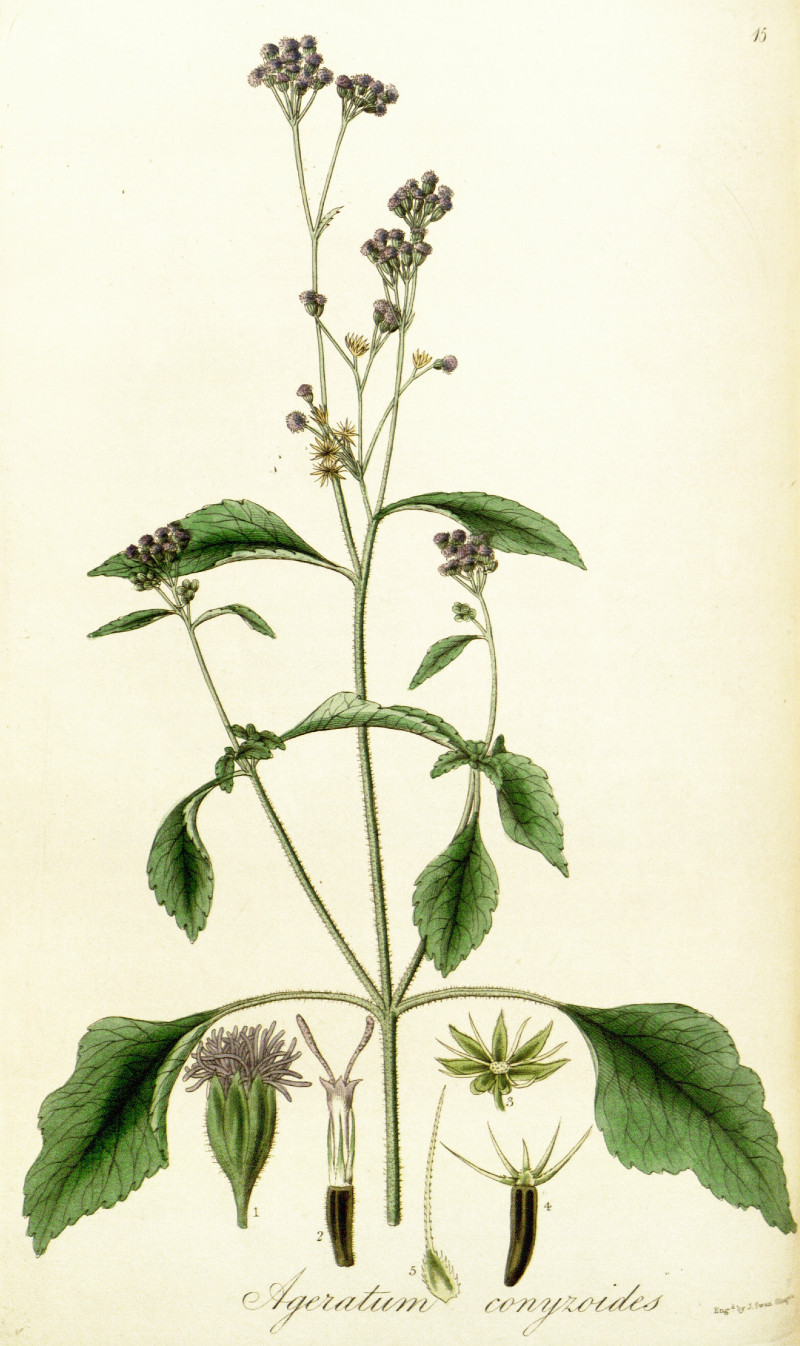Dies ist eine alte Version des Dokuments!
Ageratum conyzoides L. - syn.Ageratum ciliare Lour.; Ageratum cordifolium L.; Cacalia mentrasto Vell; Eupatorium conyzoides (L.) E.H.L. Krause. - Asteraceae
goatweed, mentrasto (port.)
Annual herb, up to 1m high, native to tropics,subtropics (America, Africa, Asia); stem pubescent; leaves opposite, crenate; flowers blue to lilac, 4-8mm across.
„The essential oils isolated from the leaves of Ageratum houstonianum Mill, and Ageratum conyzoides L. by hydrodistillation were analysed by GLC and GC-MS. The essential oil of A. houstonianum contained 7-methoxy-2,2-dimethylchromene (precocene I) and ageratochromene (precocene II) in almost similar amounts (32% and 24% respectively) whereas that of A. conyzoides was rich in precocene I (81%) and poor in precocene II (0.2%).“
[Aromatic plants of tropical central Africa. Part X Chemical composition of the essential oils of Ageratum houstonianum Mill. and Ageratum conyzoides L. from Cameroon., Menut, C., Lamaty, G., Zollo, P.H., Kuiate, J.R., Bessiere, J.M., Flavour and fragrance journal, Vol.8(1), 1993, 1-4]
„Twenty samples of A. conyzoïdes essential oil, extracted from the leaves and the roots collected in Congo during different periods of the year, are analysed by GC-MS. The content of essential oil varies randomly from 0.11 to 0.58% for the leaves and from 0.03 to 0.18 To for the roots. Oils from leaves and roots show a certain homogeneity of chemical composition. Main constituents are: β-caryophyllene (1.2 to 25.1%) and precocene 1 (63.0 to 92.9 %).“
[L'huile essentielle de Ageratum conyzoïdes., Wandji, J., Bissangou, M.F., Ouambra, J.M., Silou, T., Abena, A.A., Keita, A., Fitoterapia, Vol.67(5), 1996, 427-431]
 precocene I (R=H) and precocene II (R=OCH3)
precocene I (R=H) and precocene II (R=OCH3)
„The weed has been known since ancient times for its curative properties and has been utilized for treatment of various ailments, such as burns and wounds, for antimicrobial properties, for many infectious conditions and bacterial infections, arthrosis, headaches and dyspnea, pneumonia, analgesic, anti-inflammatory, antiasthmatic, antispasmodic and haemostatic effects, stomach ailments, gynaecological diseases, leprosy and other skin diseases. A wide range of chemical compounds including alkaloids, cumarins, flavonoids, chromenes, benzofurans, sterols and terpenoids have been isolated from this species. Extracts and metabolites from this plant have been found to possess pharmacological and insecticidal activities.“
[Kamboj A, Saluja AK. Ageratum conyzoides L.: A review on its phytochemical and pharmacological profile. Int J Green Pharm 2008;2:59-68]
http://www.greenpharmacy.info/text.asp?2008/2/2/59/41171
„Inhibitory effects of essential oil of Ageratum conyzoides, on the mycelial growth and aflatoxin B1 production by Aspergillus flavus were studied. Cultures were incubated in yeast extract-sucrose (YES) broth for days at 25 °C at the following different concentrations of the essential oil (from 0.0 to 30 μg/mL). The essential oil inhibited fungal growth to different extents depending on the concentration, and completely inhibited aflatoxin production at concentrations above 0.10 µg/mL. The analysis of the oil by GC/MS showed that its main components are precocene II (46.35%), precocene I (42.78%), cumarine (5.01%) and trans-caryophyllene (3.02%). Comparison by transmission electron microscopy of the fungal cells, control and those incubated with different concentrations of essential oil, showed ultra-structural changes which were concentration dependent of the essential oil of A. conyzoides. Such ultra-structural changes were more evident in the endomembrane system, affecting mainly the mitochondria. Degradation was also observed in both surrounding fibrils.“
[Ageratum conyzoides essential oil as aflatoxin suppressor of Aspergillus flavus., Nogueira, J.H., Gonçalez, E., Galleti, S.R., Facanali, R., Marques, M.O., Felício, J.D., International journal of food microbiology, Vol.137(1), 2010, 55-60]
„The chemical composition of the hydro-distilled essential oils of leaf, flower, stem and root of Ageratum conyzoides L. were analyzed by gas chromatography… The major constituents were 6-demethoxy-ageratochromene (precocene I) and β-caryophyllene dominated in leaf (72.3%; 12.1%), stem (66.5%; 10.2%), flower (50.3%; 14.6%) and root (79.3%; 6.0%) essential oils. The compound ageratochromene (precocene II) was found relatively high amount in flower (10.5%) than leaf (3.1%), root (0.4%) and stem (0.3%) oils. The occurrence of androencecalinol is being reported for the first time in leaf, flower, stem and root oils in low quantity (0.7 - 0.3%).“
[6-Demethoxy ageratochromene (Precocene I) Rich Essential Oil of Ageratum conyzoides L. from Western Ghats Region of North West Karnataka, India., Joshi, R.K., Journal of Essential Oil Bearing Plants, Vol.17(3), 2014, 422-426]

Hooker, W.J., Exotic Flora, vol.1, t.15 (1823)
http://plantgenera.org/species.php?id_species=29376
